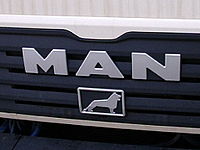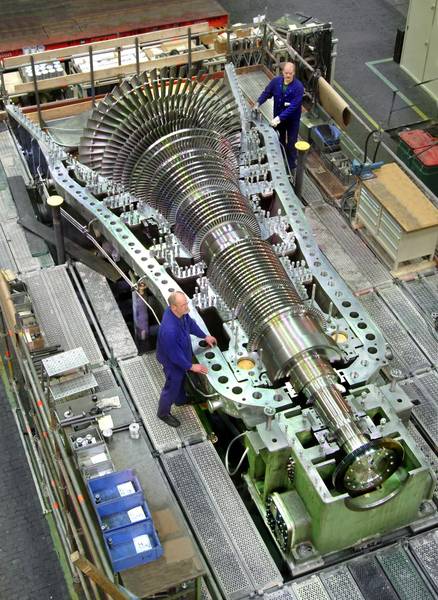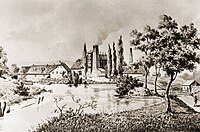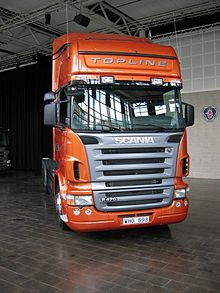Scania AB
From Wikipedia, the free encyclopedia
Coordinates:  59°10′14″N 17°38′26″E / 59.17056°N 17.64056°E / 59.17056; 17.64056
59°10′14″N 17°38′26″E / 59.17056°N 17.64056°E / 59.17056; 17.64056
Scania Aktiebolag (publ)  |
| Type | Public company -
Aktiebolag (publ)[1]
(OMX: SCV B) |
| Industry | Automotive |
| Founded | 1891[2] (as Vagnsfabriksaktiebolaget i Södertälje) |
| Headquarters | Södertälje, Sweden[2] |
| Number of locations | 10 |
| Area served | Worldwide |
| Key people | Martin Winterkorn (Chairman of the Board),[3]
Staffan Bohman (Vice Chair)[3]
Leif Östling (President and CEO),[3][4]
Jan Ytterberg (CFO)[4] |
| Products | Commercial vehicles,
diesel engines |
| Services | Financial services |
| Revenue | SEK 62,074 million (2009)[5] |
| Operating income | SEK 2,473 million (2009)[5] |
| Profit | SEK 3,365 million (2009)[5] |
| Total assets | SEK 98,451 million (2009)[5] |
| Total equity | SEK 23,303 million (2009)[5] |
| Employees | 32,330 (end 2009)[5] |
| Parent | Volkswagen Aktiengesellschaft |
| Website | Scania.com |
Scania Aktiebolag (publ), commonly referred to as Scania AB or just Scania, is a global automotive industry manufacturer of commercial vehicles - specifically heavy trucks and buses. It also manufactures diesel engines for motive power of heavy vehicles, marine, and general industrial applications.
Founded in 1891 in Södertälje, Sweden, the company's head office is still in the city. Today, Scania has ten production facilities in Sweden, France, Netherlands, Argentina, Brazil, Poland, and Russia.[2] In addition, there are assembly plants in ten countries in Africa, Asia and Europe. Scania's sales and service organisation and finance companies are worldwide. In 2008, the company employed approximately 35,000 people around the world.[2]
Scania is now majority owned by Volkswagen Aktiengesellschaft (more usually known as Volkswagen AG), the parent company of the German automotive concern, Volkswagen Group, making it the ninth marque of the Group.
Scania's logo shows a Griffin, from the coat of arms of the Swedish region of Scania (Swedish: Skåne).[6]
History
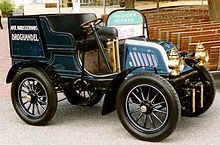
Scania Type A Tonneau 1903

A vintage Scania truck (L80 successor to the Scania-Vabis L56)
Scania AB (Scania is Latin for the province of Skåne) came from a merger between the two companies; Vabis and Scania.
Vabis and Scania
Vabis (Vagnsfabriksaktiebolaget i Södertälje) was founded in 1891 as a subsidiary of Södertälje based steel company Surahammars Bruk, manufacturing railway carriages.[7] In 1902, engineer Gustaf Erikson designed the company's first truck, powered by a petrol engine and two-speed gearbox. A year later, the first order was placed for a Vabis commercial vehicle.[7] By 1907, the company had developed a 3-ton truck, however, though it won a Swedish Royal Automobile Club award in 1909, the new range was a financial disaster for the company, failing to attract more than a handful of orders.[7]
Maskinfabriks-aktiebolaget Scania was founded in 1900 in Malmö in the south of Sweden, and was in the beginning a manufacturer of bicycles,[7] but by 1903 the first cars left the factory. Two years later, Scania built their first truck.[6]
Merger
Following the financial problems at Vabis, the companies merged in 1911,[6] creating AB Scania-Vabis. Engine and car production was moved to Södertälje, and truck production took place in Malmö.[7]
World War I and 1920s
For the next few years the company's profits stagnated, with around a third of their orders coming from abroad.[7] The outbreak of World War I, however, changed the company, with almost all output being diverted to the Swedish Army. By 1916, Scania-Vabis was making enough profit to invest in redeveloping both of their production facilities.[7]
Following the war, in 1919, Scania decided to focus completely on building trucks, abandoning other outputs including cars and buses.[7] However, they were hurt by the swamping of the market with decommissioned military vehicles from the war, and by 1921 the company was bankrupt.[6]
After some economic difficulties in 1921, new capital came from Stockholms Enskilda Bank owned by the Wallenberg family, and Scania-Vabis became a solid and technically, high standing, company.
- Denmark
Towards the end of 1913, the company established a subsidiary in Denmark. The following year the first Danish-built car, a four-seater Phaeton, was built at the company's Frederiksberg factory in Copenhagen. In 1914, the factory produced Denmark's first Scania-Vabis truck, and following this developed a V8 engine, one of the first in the world. In 1921, having sold around 175 trucks, and 75 cars, the Danish operation was closed down.[6]
1930s and 1940s
During World War II Scania produced a variety of military vehicles for the Swedish Army, including Stridsvagn m/41 light tanks produced under license.[6]
1950s and 1960s
During the 1950s, the company expanded its operations into new customer segments, becoming agents for the Willys Jeep and the Volkswagen Beetle, the latter being very profitable for Scania-Vabis. It also started to become a genuine competitor to Volvo with their new Regent truck which was introduced in 1954.[8]
During this period, Scania-Vabis was to expand its dealer network, and country-wide specialist workshop facilities. By the end of the '50s, their market-share in Sweden was between 40 to 50%, and was achieving 70% in the heaviest truck sector - helped by the entrepreneurial efforts of their dealers into the haulier market.[8]
Probably their largest impact was in export markets. Before 1950, exports accounted for only 10 percent of production output, but a decade later, exports were now at 50% of output. Beers in the Netherlands became a very important partner. Beers became official importers for Scania-Vabis in the Netherlands, and established a dealer network, along with training programmes for both mechanics and drivers. Beers also offered free twice-yearly overhauls of their customers vehicles, and offered a mobile service throughout the Netherlands with their custom-equipped service trucks. Due to Beers concerted efforts, Scania-Vabis market share in the country remained at a consistent 20% throughout this period. Scania-Vabis were to adopt the business model of Beers in their own overseas sales operations.[8]
The 1960s saw Scania-Vabis expanding its production operations into overseas locations. Until now, all Scania-Vabis production had been carried out solely at Södertälje, but the '60s saw the need to expand production overseas. Brazil was becoming a notable market for heavy trucks, and was also dependent on inter-urban buses, with particular requirement for Brazils mountainous roads which became nigh-on impassable at times.[9] Scania-Vabis established its first production plant outside Södertälje, by building a new facility at São Bernardo do Campo in Brazil, which was completed in 1962, and this was to set the standard for Scania-Vabis international operations.[9]
Closer to home, the recently formed European Economic Community (EEC) offered further opportunities. Based on their now strong presence in the Dutch markets, Scania-Vabis constructed a new plant in Zwolle, which was completed in 1964.[9] This new Dutch facility provided Scania-Vabis with a stepping stone into the other five EEC countries, particularly the German and French markets.[9]
In 1966, Scania-Vabis acquired ownership of a then valuable competitor - Be-Ge Karosserifabrik, who were based in Oskarshamn. Be-Ge had been making truck cabs since 1946, and had been supplying cabs not only to Scania-Vabis, but also to their Swedish competitors Volvo. If was normal practice for truck manufacturers to outsource production of cabs to independent bodybuilders, so their acquisition by Scania-Vabis seemed a good move.[9] Be-Ge owner Bror Göthe Persson had also established an additional cab factory at Meppel.[9]
Scania-Vabis continued their expansion of production facilities through acquisitions. In 1967, they acquired Katrineholm based coachwork company Svenska Karosseri Verkstäderna, and created a new subsidiary, Scania-Bussar. A year later, all bus production, along with R&D was moved to Katrineholm.[9] Further production locations were added at Sibbhult and Falun, and Scanias employee numbers rose, particularly at Södertälje, which was to help double the towns population.[9]
Saab-Scania AB
In 1969, Scania-VABIS merged with SAAB, and formed Saab-Scania AB. When Saab-Scania was split in 1995, the name of the truck and bus division changed simply to Scania AB. One year later, Scania AB was introduced on the stock exchange, which resulted in a minor change of name to Scania AB (publ).
Many examples of Scania, Vabis and Scania-Vabis commercial and military vehicles can be seen at the Marcus Wallenberg-hallen (the Scania Museum) in Södertälje.
Ownership
Aborted Volvo takeover
On 7 August 1999, Volvo announced it had agreed to acquire a majority share in Scania. Volvo was to buy the 49.3% stake in Scania that was owned by Investor AB, Scania's then main shareholder. The acquisition, for $7.5 billion (60.7 billion SEK), would have created the world's second-largest manufacturer of heavy trucks, behind DaimlerChrysler. The cash for the deal came from Volvo selling its car division to Ford Motor Company in January 1999, but the deal had yet to be appproved by the European Union.[10]
The deal eventually failed, after the European Union had disapproved of the affair, saying it would create a company with almost 100% market share[11] in the Nordic markets.[citation needed]
Aborted MAN takeover
In September 2006, the German truckmaker MAN AG launched a €10.3bn hostile offer to acquire Scania AB. Scania's CEO Leif Östling was forced to apologise for comparing the bid of MAN to a "Blitzkrieg". MAN AG later dropped its hostile offer, but in January 2008, MAN increased their voting rights in Scania up to 17%.
Scania ownership today
The two major stockholders of Scania AB (publ) are:
- The German automotive company Volkswagen AG is Scania's biggest shareholder, with a 70.94% voting stake (equity) in Scania.[12] It gained this by first buying Volvo's stake in 2000, after the latter's aborted takeover attempt, increasing it to 36.4% in the first quarter 2007,[13] and then buying the remainder from Investor AB in March 2008.[14] The deal was approved by regulatory bodies in July 2008.[11] Scania then became the ninth marque in the Volkswagen Group.[15]
- The German truck manufacturer MAN SE holds a 17.37% voting stake in Scania.[12] Notably, Volkswagen AG[11] also owns a 29.9% voting stake in MAN, acquired in Q1 2007.[13]
Current shareholders
Scania AB (publ) has a total issue of 400 million 'A shares' and 400 million 'B shares', with a total capitalised value of SEK 72,880 million.[12] In terms of voting rights, one 'A share' is eligible for one vote, whereas 10 'B shares' are required for one vote.[16]
As of 29 January 2010 (2010 -01-29)[ref], these shares, as published by Swedish Central Securities Depository and Clearing Organisation ("Euroclear"), are allocated to 119,973 owners, and the table below details the top ten shareholders.[12]
Scania AB (publ) principal shareholders[12] | shareholder name | A shares | B shares | % of capital | % of votes |
| Volkswagen Aktiengesellschaft * | 306,232,239 | 59,037,822 | 45.66 | 70.94 |
| MAN SE | 73,047,179 | 33,718,857 | 13.35 | 17.37 |
| Clearstream Banking | 1,170,514 | 32,973,450 | 4.27 | 1.02 |
| JP Morgan Chase Bank | 461,584 | 36,220,219 | 4.59 | 0.93 |
| Swedbank Robur Fonder | 0 | 29,043,665 | 3.63 | 0.66 |
| Skandia Liv | 974,374 | 9,646,318 | 1.33 | 0.44 |
| Alecta Pensionsförsäkring | 0 | 19,085,000 | 2.39 | 0.33 |
| AMF Försäkring och fonder | 650,000 | 9,678,411 | 1.23 | 0.36 |
| Handelsbanken fonder | 0 | 7,202,362 | 0.90 | 0.16 |
| Government of Norway | 0 | 6,937,665 | 0.87 | 0.16 |
| largest 10 owners | 382,535,890 | 243,021,708 | 78.19 | 92.46 |
| Others | 17,464,110 | 156,978,292 | 21.81 | 7.54 |
| total ownership | 400,000,000 | 400,000,000 | 100.00 | 100.00 |
* Further to the shares listed above, Volkswagen AG holds additional shares in trust by a credit institution of Scania, which further gives additional voting rights amounting to 0.87 percent and an equity interest of 3.63 percent attributable to Volkswagen AG, as disclosed in January 2009.
Products
Scania develops, manufactures and sells trucks with a gross vehicle weight of more than 16 tonnes (Class 8),[clarification needed] intended for long-distance haulage, regional, and local distribution of goods, as well as construction haulage.
Scania's bus range is concentrated on bus chassis, intended for use in tourist coaches, as well as urban and intercity traffic.
Scania's industrial and marine engines are used in generator sets and in earthmoving and agricultural machinery, as well as on board ships and pleasure crafts.
[edit] Current
- Trucks / Special vehicles
- P-series - typical applications are regional and local distribution, construction, and various specialised operations associated with locally-based transportation and services. P-series trucks have the new P cabs, which are available in three variations: a single-berth sleeper, a spacious day cab and a short cab
- G-series - the G-series models offer an enlarged range of options for operators engaged in national long haul and virtually all types of construction applications. All models have a G cab, and each is available as a tractor or rigid. The G-series truck comes with five cab variants: three sleepers, a day cab and a short cab. There are different axle configurations, and in most cases a choice of chassis height and suspension
- R-series - the R-series model range debuted in 2004, and won the prestigious International Truck of the Year award in 2005 and again in 2010.[17] The range offers various trucks optimised for long haulage. All models have a Scania R cab, and each vehicle is available as a tractor or rigid. There are different axle configurations and a choice of chassis height and suspension. The Scania R730, the most powerful vatiant of the R-series, currently holds the record for the most powerful production truck. Its 16.4 Liter DC16 Turbo Diesel V8 engine produces 730 PS (540 kW; 720 hp) at 1,900 rpm and 3,500 N·m (2,600 lb·ft) of torque at 1,000 - 1,350 rpm.
- Buses
- Diesel engines
Scania's involvement with internal combustion engine production dates back to 1897, when engineer Gustav Erickson designed the engine for the company's first motor car. Over the subsequent years, Scania has grown to be one of the world's most experienced engine manufacturers, building engines not only for trucks and buses, but also for marine and general industrial applications, which are exported across the globe.[18]
Historical

Scania K113TRBL 14.5m quad-axle coach
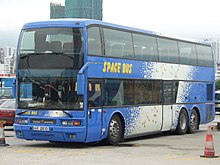
Scania K124EB double decker coach
- Buses
- Trucks / Special Vehicles
- Diesel engines
Model designation (3-series)
The model designation breakdown is as follows:
- Main type
- Engine series
- 9: DN9 or DS9 series engine
- 11: DS11 or DSC11 series engine
- Development code
- Chassis type
- A: chassis for articulated bus
- C: chassis for single-decker, two-axle bus
- D: chassis for double-decker bus
- N: F-chassis for heavy-duty execution
- T: chassis for single-decker or double-decker bus with trailing axle
- Steering wheel location
- L: left hand drive
- R: right hand drive
Production sites
The table below shows the locations of the current[20] and former production facilities of Scania AB. As Scania is now majority owned by Volkswagen AG, making it part of Volkswagen Group, the table also includes Volkswagen Group references.[21]
Notes: In the second column of the table:- the 'factory VIN ID code', this is indicated in the 11th digit of the vehicles' 17 digit Vehicle Identification Number, and this factory code is only assigned to plants which produce actual vehicles. Component factories which do not produce complete vehicles do not have this factory ID code.
factory
name | factory
VIN ID code(s) | location
(continent,
country) | location
(town / city,
state / region) | current
motor vehicle
production | former
motor vehicle
production | automotive
products &
components | year
opened | year
closed | number of
employees | comments | factory
coordinates |
Angers
[21][22] | 9 | Europe,
France | Angers,
Maine-
et-Loire,
Pays de la Loire | Scania truck assembly |
|
|
|
| 548 | Scania Production S.A.S. factory and assembly line, part of Scania AB |  47°30′4″N 0°30′55″W / 47.50111°N 0.51528°W / 47.50111; -0.51528 (Scania Production S.A.S., Angers) 47°30′4″N 0°30′55″W / 47.50111°N 0.51528°W / 47.50111; -0.51528 (Scania Production S.A.S., Angers) |
Luleå
[21][23] |
| Europe,
Sweden | Luleå Municipality,
Norrbotten,
Norrbotten County |
|
| Scania truck frame members, Rear axle housings |
|
| 713 | Ferruform AB factory, part of Scania AB |  65°36′48″N 22°7′45″E / 65.61333°N 22.12917°E / 65.61333; 22.12917 (Ferruform AB, Luleå (part of Scania AB)) 65°36′48″N 22°7′45″E / 65.61333°N 22.12917°E / 65.61333; 22.12917 (Ferruform AB, Luleå (part of Scania AB)) |
Meppel
[21][24] |
| Europe,
Netherlands | Meppel,
Drenthe |
|
| Scania truck components and paint shop |
|
| 75 | Scania Production Meppel B.V. factory, part of Scania AB |  52°41′25″N 6°10′24″E / 52.69028°N 6.17333°E / 52.69028; 6.17333 (Scania Production Meppel B.V., Meppel) 52°41′25″N 6°10′24″E / 52.69028°N 6.17333°E / 52.69028; 6.17333 (Scania Production Meppel B.V., Meppel) |
Oskarshamn
[21][25] |
| Europe,
Sweden | Oskarshamn Municipality,
Kalmar County,
Småland |
|
| Scania truck Cab production |
|
| 2,172 | Scania AB factory |  57°15′24″N 16°25′42″E / 57.25667°N 16.42833°E / 57.25667; 16.42833 (Scania AB production plant, Oskarshamn) 57°15′24″N 16°25′42″E / 57.25667°N 16.42833°E / 57.25667; 16.42833 (Scania AB production plant, Oskarshamn) |
São
Bernardo
do
Campo | 3 | South
America,
Brazil | São Bernardo
do Campo,
Greater São Paulo,
São Paulo state |
| Scania-Vabis trucks and buses |
| 1959 |
| 0 | Originally a Scania-Vabis truck plant. Now known as Anchieta,[21] oldest currently operating Volkswagen Group factory outside of Germany and part of Volkswagen do Brasil Indústria de Veículos Automotores Ltda. |  23°44′07″S 46°32′48″W / 23.735217°S 46.54653°W / -23.735217; -46.54653 (formerly: Scania-Vabis São Bernardo do Campo, 23°44′07″S 46°32′48″W / 23.735217°S 46.54653°W / -23.735217; -46.54653 (formerly: Scania-Vabis São Bernardo do Campo,
now: Volkswagen Anchieta) |
São
Paulo
[21][26] |
| South
America,
Brazil | São Paulo,
Greater São Paulo,
São Paulo state | Scania trucks
Scania bus chassis |
| Engines
Axles |
|
| 2,299 | Scania Latin America Ltda., part of Scania AB |  23°42′49″S 46°33′58″W / 23.71361°S 46.56611°W / -23.71361; -46.56611 (Scania Latin America Ltda., São Paulo) 23°42′49″S 46°33′58″W / 23.71361°S 46.56611°W / -23.71361; -46.56611 (Scania Latin America Ltda., São Paulo) |
Słupsk
[21][27] |
| Europe,
Poland | Słupsk,
Pomeranian
Voivodeship | Scania bus
body assembly |
|
|
|
| 747 | Scania Production Slupsk S.A factory and assembly line, part of Scania AB |  54°28′42″N 17°0′46″E / 54.47833°N 17.01278°E / 54.47833; 17.01278 (Scania Production Slupsk S.A) 54°28′42″N 17°0′46″E / 54.47833°N 17.01278°E / 54.47833; 17.01278 (Scania Production Slupsk S.A) |
Södertälje
[21][28] | 1
2 | Europe,
Sweden | Södertälje,
Södertälje Municipality,
Södermanland,
Stockholm County | Scania trucks
Scania bus chassis |
| Components,
Engines |
|
| 8,700 | Scania AB headquarters, R&D and main production plant |  59°10′14″N 17°38′26″E / 59.17056°N 17.64056°E / 59.17056; 17.64056 (Scania AB Headquarters & production plant, Södertälje) 59°10′14″N 17°38′26″E / 59.17056°N 17.64056°E / 59.17056; 17.64056 (Scania AB Headquarters & production plant, Södertälje) |
St Petersburg
[21][29] |
| Asia,
Russia | St Petersburg,
Northwestern Federal District | Scania bus
body assembly |
|
|
|
| 204 | OOO Scania Peter factory and assembly line, part of Scania AB |
|
Tucumán
[21][30] |
| South
America,
Argentina | San Miguel de Tucumán,
Tucumán Province |
|
| Rear axle gears |
|
| 649 | Scania Argentina S.A. factory, part of Scania AB |  26°52′47.5″S 65°7′38″W / 26.879861°S 65.12722°W / -26.879861; -65.12722 (Scania Argentina S.A., Tucamán) 26°52′47.5″S 65°7′38″W / 26.879861°S 65.12722°W / -26.879861; -65.12722 (Scania Argentina S.A., Tucamán) |
Zwolle
[21][31] | 4
5 | Europe,
Netherlands | Zwolle,
Overijssel | Scania truck assembly |
|
| 1964 |
| 1,437 | Scania Nederland B.V. factory, part of Scania AB |  52°30′46″N 6°3′48″E / 52.51278°N 6.06333°E / 52.51278; 6.06333 (Scania Nederland B.V., Zwolle) 52°30′46″N 6°3′48″E / 52.51278°N 6.06333°E / 52.51278; 6.06333 (Scania Nederland B.V., Zwolle) |
factory
name | factory
VIN ID code(s) | location
(continent,
country) | location
(town / city,
state / region) | current
motor vehicle
production | former
motor vehicle
production | automotive
products &
components | year
opened | year
closed | number of
employees | comments | factory
coordinates |
See also
References
- ^ "Scania Group - Governance structure". Scania.com. Scania AB (publ). http://www.scania.com/scania-group/corporate-governance/governance-structure/. Retrieved 6 October 2009.
- ^ a b c d "Scania Group - Key figures Scania (2008)". Scania.com. Scania AB (publ). http://www.scania.com/scania-group/scania-in-brief/key-figures/. Retrieved 6 October 2009.
- ^ a b c "Scania Group - Composition of the Board". Scania.com. Scania AB (publ). http://www.scania.com/scania-group/corporate-governance/board-of-directors/boards-composition/. Retrieved 6 October 2009.
- ^ a b "Scania Group - Executive Board". Scania.com. Scania AB (publ). http://www.scania.com/scania-group/corporate-governance/management-organisational-structure/executive-board/. Retrieved 6 October 2009.
- ^ a b c d e f "Annual Results 2009" (PDF). Scania Group. http://www.scania.com/Images/Scania%20Year-end%20Report%202009_179708.pdf. Retrieved 2010-03-05.
- ^ a b c d e f "The history of Scania". TruckerLinks.dk. http://www.truckerlinks.dk/engelsk/scania.htm. Retrieved 2009-06-03.
- ^ a b c d e f g h "Scania; History". AutoEvolution.com. Softnews NET. http://www.autoevolution.com/trucks/scania/history/. Retrieved 2009-06-03.
- ^ a b c "Scania Group - 1950 - Growth and new frontiers". Scania.com. Scania AB (publ). http://www.scania.com/scania-group/history-of-scania/1950/. Retrieved 7 October 2009.
- ^ a b c d e f g h "Scania Group - 1960 - Expanding production". Scania.com. Scania AB (publ). http://www.scania.com/scania-group/history-of-scania/1960/. Retrieved 7 October 2009.
- ^ "Volvo buys Scania". DieselNet.com. Ecopoint Inc.. 7 August 1999. http://www.dieselnet.com/news/1999/08volvo.php. Retrieved 6 October 2009.
- ^ a b c "Volkswagen (Group) increases Scania shareholding". PaulTan.org. 18 July 2008. http://paultan.org/archives/2008/07/18/volkswagen-increases-scania-shareholding/. Retrieved 6 October 2009.
- ^ a b c d e f "Scania Group - Ownership". Scania.com. Scania AB (publ). http://www.scania.com/scania-group/corporate-governance/ownership/. Retrieved 27 December 2009.
- ^ a b "Volkswagen Aktiengesellschaft - January-March 2007 Interim Report" (PDF). VolkswagenAG.com (Volkswagen Aktiengesellschaft, Wolfsburg): 1, 3. May 2007. http://www.volkswagenag.com/vwag/vwcorp/info_center/en/publications/2007/05/interim_report_jan_mar07.-bin.acq/qual-BinaryStorageItem.Single.File/Q1_2007_e.pdf. Retrieved 6 October 2009.
- ^ "VW CEO hints there will be no merger of Scania and MAN". Thomson Financial. http://www.hemscott.com/news/latest-news/item.do?newsId=60917668904265. Retrieved 2008-03-21. [registration required][verification needed]
- ^ Volkswagen Aktiengesellschaft (1 December 2008). "Scania has become the ninth brand in the Volkswagen Group". Press release. http://www.volkswagenag.com/vwag/vwcorp/info_center/en/themes/2008/12/scania.html. Retrieved 10 November 2009.
- ^ "Scania Group - Voting rights". Scania.com. Scania AB (publ). http://www.scania.com/scania-group/corporate-governance/general-meeting/voting-rights/. Retrieved 6 October 2009.
- ^ "International Truck and Van of the Year 2005". TNN.co.uk. Transport News Network Ltd.. 08/04/2005. http://www.tnn.co.uk/UKNews/plonearticle.2004-09-28.5605197718. Retrieved 6 October 2009.
- ^ "Scania - Undisturbed pleasure". KellysTruckMarineService.com.au. Kelly's Truck and Marine Service - Scania specialists. http://www.kellystruckmarineservice.com.au/Mar1.htm. Retrieved 6 October 2009.
- ^ "Scania Group - 2000 - A strong brand in a new century". Scania.com. Scania AB (publ). 2009. http://www.scania.com/scania-group/history-of-scania/2000/. Retrieved 13 February 2010.
- ^ "Scania Group - Production units". Scania.com. Scania AB (publ). 2008. http://www.scania.com/scania-group/scania-around-the-world/production-units/. Retrieved 4 October 2009.
- ^ a b c d e f g h i j k l "Volkswagen Group - Production Plants". VolkswagenAG.com. Volkswagen Aktiengesellschaft. 31 December 2008. http://www.volkswagenag.com/vwag/vwcorp/content/en/the_group/production_plants.html. Retrieved 4 October 2009.
- ^ "Scania Group - France, Angers". Scania.com. Scania AB (publ). 2008. http://www.scania.com/scania-group/scania-around-the-world/production-units/angers.aspx. Retrieved 4 October 2009.
- ^ "Scania Group - Sweden, Luleå". Scania.com. Scania AB (publ). 2008. http://www.scania.com/scania-group/scania-around-the-world/production-units/lulea.aspx. Retrieved 4 October 2009.
- ^ "Scania Group - The Nederlands, Meppel". Scania.com. Scania AB (publ). 2008. http://www.scania.com/scania-group/scania-around-the-world/production-units/meppel.aspx. Retrieved 4 October 2009.
- ^ "Scania Group - Sweden, Oskarshamn". Scania.com. Scania AB (publ). 2008. http://www.scania.com/scania-group/scania-around-the-world/production-units/oskarshamn.aspx. Retrieved 4 October 2009.
- ^ "Scania Group - Brazil, São Paulo". Scania.com. Scania AB (publ). 2008. http://www.scania.com/scania-group/scania-around-the-world/production-units/sao-paulo.aspx. Retrieved 4 October 2009.
- ^ "Scania Group - Poland, Slupsk". Scania.com. Scania AB (publ). 2008. http://www.scania.com/scania-group/scania-around-the-world/production-units/slupsk.aspx. Retrieved 4 October 2009.
- ^ "Scania Group - Sweden, Södertälje". Scania.com. Scania AB (publ). 2008. http://www.scania.com/scania-group/scania-around-the-world/production-units/sodertalje.aspx. Retrieved 4 October 2009.
- ^ "Scania Group - Russia, St. Petersburg". Scania.com. Scania AB (publ). 2008. http://www.scania.com/scania-group/scania-around-the-world/production-units/st-petersburg.aspx. Retrieved 4 October 2009.
- ^ "Scania Group - Argentina, Tucamán". Scania.com. Scania AB (publ). 2008. http://www.scania.com/scania-group/scania-around-the-world/production-units/tucaman.aspx. Retrieved 4 October 2009.
- ^ "Scania Group - The Nederlands, Zwolle". Scania.com. Scania AB (publ). 2008. http://www.scania.com/scania-group/scania-around-the-world/production-units/zwolle.aspx. Retrieved 4 October 2009.

